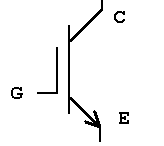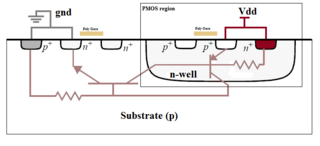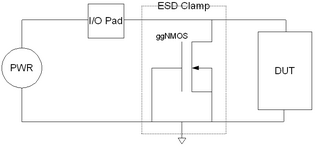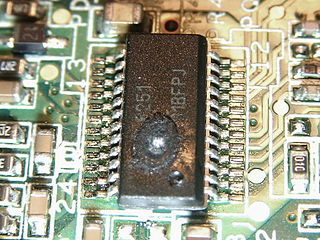
A transistor is a semiconductor device used to amplify or switch electronic signals and electrical power. It is composed of semiconductor material usually with at least three terminals for connection to an external circuit. A voltage or current applied to one pair of the transistor's terminals controls the current through another pair of terminals. Because the controlled (output) power can be higher than the controlling (input) power, a transistor can amplify a signal. Today, some transistors are packaged individually, but many more are found embedded in integrated circuits.
Transistor–transistor logic (TTL) is a logic family built from bipolar junction transistors. Its name signifies that transistors perform both the logic function and the amplifying function ; it is the same naming convention used in resistor–transistor logic (RTL) and diode–transistor logic (DTL).

A bipolar junction transistor is a type of transistor that uses both electrons and holes as charge carriers.

A Zener diode is a type of diode that allows current to flow not only from its anode to its cathode, but also in the reverse direction, when the Zener voltage is reached.

An insulated-gate bipolar transistor (IGBT) is a three-terminal power semiconductor device primarily used as an electronic switch which, as it was developed, came to combine high efficiency and fast switching. It consists of four alternating layers (P-N-P-N) that are controlled by a metal-oxide-semiconductor (MOS) gate structure without regenerative action. Although the structure of the IGBT is topologically the same as a thyristor with a 'MOS' gate, the thyristor action is completely suppressed and only the transistor action is permitted in the entire device operation range. It is used in switching power supplies in high power applications: variable-frequency drives (VFDs), electric cars, trains, variable speed refrigerators, lamp ballasts, and air-conditioners.

The Schottky diode, also known as Schottky barrier diode or hot-carrier diode, is a semiconductor diode formed by the junction of a semiconductor with a metal. It has a low forward voltage drop and a very fast switching action. The cat's-whisker detectors used in the early days of wireless and metal rectifiers used in early power applications can be considered primitive Schottky diodes.
In electronics, an avalanche diode is a diode that is designed to experience avalanche breakdown at a specified reverse bias voltage. The junction of an avalanche diode is designed to prevent current concentration and resulting hot spots, so that the diode is undamaged by the breakdown. The avalanche breakdown is due to minority carriers accelerated enough to create ionization in the crystal lattice, producing more carriers which in turn create more ionization. Because the avalanche breakdown is uniform across the whole junction, the breakdown voltage is nearly constant with changing current when compared to a non-avalanche diode.

A transient-voltage-suppression (TVS) diode, also transil or thyrector, is an electronic component used to protect electronics from voltage spikes induced on connected wires.

A single-photon avalanche diode (SPAD) is a solid-state photodetector in which a photon-generated carrier can trigger a short-duration but relatively large avalanche current. This avalanche is created through a mechanism called impact ionization, whereby carriers are accelerated to high kinetic energies through a large potential gradient (voltage). If the kinetic energy of a carrier is sufficient further carriers are liberated from the atomic lattice. The number of carriers thus increases exponentially from, in some cases, as few as a single carrier. This mechanism was observed and modeled by John Townsend for trace-gas vacuum tubes, becoming known as a Townsend discharge, and later being attributed to solid-state breakdown by K. McAfee. This device is able to detect low-intensity ionizing radiation, including: gamma, X-ray, beta, and alpha-particle radiation along with electromagnetic signals in the UV, Visible and IR. SPADs are also able to distinguish the arrival times of events (photons) with a timing jitter of a few tens of picoseconds.

For power semiconductor devices, the safe operating area (SOA) is defined as the voltage and current conditions over which the device can be expected to operate without self-damage.
Radiation hardening is process of making electronic components and circuits resistant to damage or malfunction caused by high levels of ionizing radiation, especially for environments in outer space and high-altitude flight, around nuclear reactors and particle accelerators, or during nuclear accidents or nuclear warfare.

The breakdown voltage of an insulator is the minimum voltage that causes a portion of an insulator to become electrically conductive.
An IMPATT diode is a form of high-power semiconductor diode used in high-frequency microwave electronics devices. They have negative resistance and are used as oscillators and amplifiers at microwave frequencies. They operate at frequencies of about 3 and 100 GHz, or higher. The main advantage is their high-power capability; single IMPATT diodes can produce continuous microwave outputs of up to 3 kilowatts, and pulsed outputs of much higher power. These diodes are used in a variety of applications from low-power radar systems to proximity alarms. A major drawback of IMPATT diodes is the high level of phase noise they generate. This results from the statistical nature of the avalanche process.

A latch-up is a type of short circuit which can occur in an integrated circuit (IC). More specifically it is the inadvertent creation of a low-impedance path between the power supply rails of a MOSFET circuit, triggering a parasitic structure which disrupts proper functioning of the part, possibly even leading to its destruction due to overcurrent. A power cycle is required to correct this situation.

A power MOSFET is a specific type of MOSFET designed to handle significant power levels.
An avalanche transistor is a bipolar junction transistor designed for operation in the region of its collector-current/collector-to-emitter voltage characteristics beyond the collector-to-emitter breakdown voltage, called avalanche breakdown region. This region is characterized by avalanche breakdown, which is a phenomenon similar to Townsend discharge for gases, and negative differential resistance. Operation in the avalanche breakdown region is called avalanche-mode operation: it gives avalanche transistors the ability to switch very high currents with less than a nanosecond rise and fall times. Transistors not specifically designed for the purpose can have reasonably consistent avalanche properties; for example 82% of samples of the 15V high-speed switch 2N2369, manufactured over a 12-year period, were capable of generating avalanche breakdown pulses with rise time of 350 ps or less, using a 90V power supply as Jim Williams writes.

Grounded-gate NMOS, commonly known as ggNMOS, is an electrostatic discharge (ESD) protection device used within CMOS integrated circuits (ICs). Such devices are used to protect the inputs and outputs of an IC, which can be accessed off-chip and are therefore subject to ESD when touched. An ESD event can deliver a large amount of energy to the chip, potentially destroying input/output circuitry; a ggNMOS device or other ESD protective devices provide a safe path for current to flow, instead of through more sensitive circuitry. ESD protection by means of such devices or other techniques is important to product reliability: 35% of all IC failures in the field are associated with ESD damage.
In electronics, leakage is the gradual transfer of electrical energy across a boundary normally viewed as insulating, such as the spontaneous discharge of a charged capacitor, magnetic coupling of a transformer with other components, or flow of current across a transistor in the "off" state or a reverse-polarized diode.

Electronic components have a wide range of failure modes. These can be classified in various ways, such as by time or cause. Failures can be caused by excess temperature, excess current or voltage, ionizing radiation, mechanical shock, stress or impact, and many other causes. In semiconductor devices, problems in the device package may cause failures due to contamination, mechanical stress of the device, or open or short circuits.












